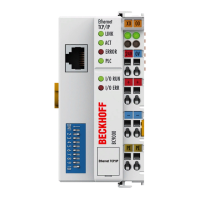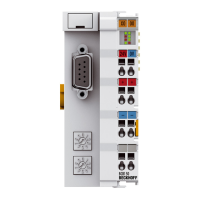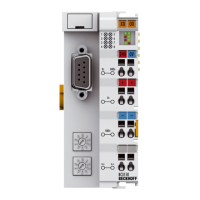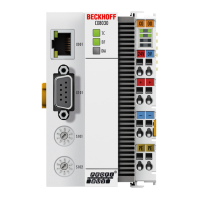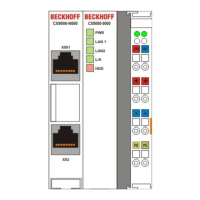Fieldbus system
BC9000 and BC9100 53Version: 4.0.0
7.2 Topology
In 10BaseT and 100BaseT a number of stations are star connected according to the Ethernet standard.
Star topology
The simplest form of a star LAN consists of a single point-to-point connection. All messages pass via a
central node (the hub or switch), which then passes the information to the desired device according to the
destination address.
Tree topology
A tree topology consists of a number of connected star networks. As soon as the network contains a number
of hubs or switches, the topology is classified as a tree. Ideally the connections between the star couplers
have a particularly wide bandwidth, since these transport the most traffic. When constructing tree topologies,
the repeater rule must be observed. This is also known as the 5-4-3 repeater rule. There must be no more
than two pairs of repeaters (or of hubs) in the transmission path between any two stations, unless they are
separated by bridges, switches or routers. A transmission path may consist of at most five segments and
four repeater sets (two repeater pairs). Up to three of these segments may be coaxial segments to which the
stations are connected. The remaining segments must consist of point-to-point connections; these are also
known as IRL (inter repeater link) connections.
Cabling guidelines
Structured cabling provides general guidelines for constructing the cabling for a LAN. It specifies maximum
permitted cable lengths for the wiring within the grounds, building or floor. Standardized in EN 50173, ISO
11801 and TIA 568-A, structured cabling provides the basis for an advanced, application-independent and
economical network infrastructure. The wiring standards are applicable to a range defined as having a
geographical extent of up to 3km and an office area of up to one million sq meters, with between 50 and
50,000 end devices. Recommendations for the structure of a cabling system are also given. The figures can
vary, depending on the topology selected, the transmission media and coupling modules used under
industrial conditions, and on the use of components from various manufacturers in one network. The given
figures should therefore only be considered as recommendations.
7.3 Reaction times
BC9000 reaction time
ADS Time [ms]
TCP 23 to 50 ms + task time on the BC9000 (jitter)
UDP 2 to 3 ms + task time on the BC9000 (jitter)
Modbus Time [ms]
TCP 12 to 15 ms + task time on the BC9000 (jitter) (default)
Fast TCP* 1 to 3 ms + task time on the BC9000 (jitter)
* as from firmware B7, Table 100, Register 29 - "1" Fast TCP / "0" TCP (see Modbus Interface) [}65]
BK9000 reaction time
ADS Time [ms]
TCP 23 to 50 ms
UDP 2 to 3 ms

